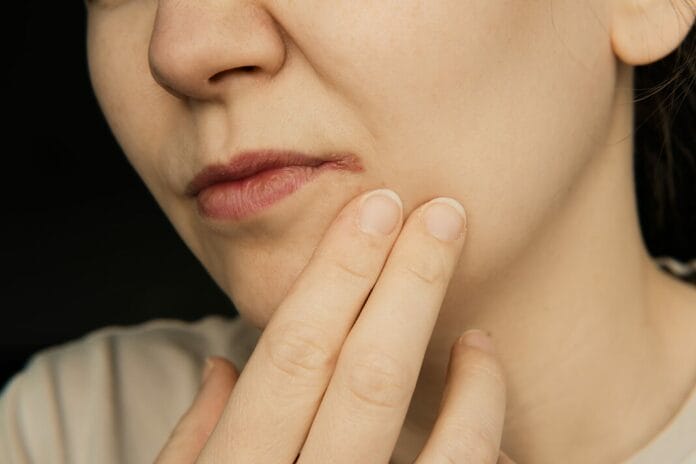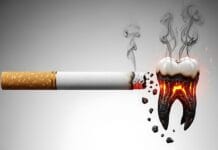Are you in need of CE credits? If so, check out our peer-reviewed, self-study CE courses here.
Test Your Angular Cheilitis Knowledge
1. Angular cheilitis is an inflammatory skin process of variable etiology at the labial commissure.
Angular cheilitis is described as an inflammatory skin process of variable etiology occurring at the labial commissure. Symptoms are often mild, and the condition could be present for years before proper treatment is provided.
Angular cheilitis is also referred to as angular cheilosis, angular stomatitis, commissural stomatitis, rhagades, or perleche.
Federico, J.R., Basehore, B.M., Zito, P.M. (2023, March 7). Angular Cheilitis. StatPearls. https://www.ncbi.nlm.nih.gov/books/NBK536929/
2. Allergic or irritant contact dermatitis is one of the variable etiologies of angular cheilitis. Which of the following is a common cause?
Allergic or irritant contact dermatitis causes up to 22% of cases of angular cheilitis. Common causes include orthodontic brackets with nickel, food coloring, preservatives, toothpaste, mouthwash, the sunscreen component of expired lip balm, cosmetics, acne medications, and chewing gum.
It is unlikely that dental professionals will be able to distinguish between allergic dermatitis and irritant contact dermatitis without a patch test to confirm etiology. Treatment in these cases is to eliminate the irritant or allergen, which may take some trial and error to determine the source of the allergen or irritant.
Federico, J.R., Basehore, B.M., Zito, P.M. (2023, March 7). Angular Cheilitis. StatPearls. https://www.ncbi.nlm.nih.gov/books/NBK536929/
3. Immune deficiency causes angular cheilitis, often via the development of oral candidiasis. Nutritional deficiencies are less common in developed countries; therefore, angular cheilitis is not associated with nutritional deficiencies in developed countries.
Immune deficiency is a common cause of angular cheilitis, often resulting from oral candidiasis. Chronic steroid use (inhaled or oral), HIV/AIDS, thymic aplasia, severe combined immunodeficiency syndrome (SCID), DiGeorge syndrome, hereditary myeloperoxidase deficiency, and Chediak-Higashi syndrome can all lead to immune suppression. Additionally, blood disorders and certain malignancies, such as acute leukemia and agranulocytosis, may contribute to immune suppression.
Nutritional deficiencies, though less common in developed countries, still exist among individuals, especially in older adults, those with celiac disease, those with low socioeconomic status, individuals with a mental illness, vegans, and exclusively breastfed infants without vitamin supplementation.
People who have undergone bariatric surgery or ileal resection are also at risk due to nutrient deficiencies. Other significant risk factors include chronic gastritis, chronic pancreatitis, Crohn's disease, and pernicious anemia. Up to 25% of angular cheilitis cases are estimated to be linked to iron or vitamin B deficiencies.
Federico, J.R., Basehore, B.M., Zito, P.M. (2023, March 7). Angular Cheilitis. StatPearls. https://www.ncbi.nlm.nih.gov/books/NBK536929/
4. Glucagonoma, a pancreatic endocrine tumor, is a rare cause of angular cheilitis.
Glucagonoma is a rare pancreatic neuroendocrine tumor. The tumor can release excessive glucagon, which leads to hyperglycemia and diabetes. Aside from diabetes and symptoms associated with diabetes, glucagonoma can also cause dermatitis, weight loss, anemia, and angular cheilitis.1,2
Management of symptoms depends on the management of the underlying disease. Localized glucagonoma tumors can be removed via surgery. With successful removal, glucagon levels stabilize, and symptoms resolve.2
If surgery is not an option or the tumor cannot be removed, managing symptoms may be the best option in addition to traditional cancer therapy.2
1. Federico, J.R., Basehore, B.M., Zito, P.M. (2023, March 7). Angular Cheilitis. StatPearls. https://www.ncbi.nlm.nih.gov/books/NBK536929/
2. Glucagonoma. (2023, September 13). Cleveland Clinic. https://my.clevelandclinic.org/health/diseases/25246-glucagonoma
5. Which of the following is the most common pathophysiological cause of angular cheilitis?
The most common pathophysiological cause of angular cheilitis is overexposure to saliva at the corners of the mouth. Saliva's digestive enzymes can break down body tissues if contact persists, leading to irritation. Continuous exposure can cause contact dermatitis and an eczematous reaction at the corners of the mouth.
Overexposure to saliva also weakens the skin barrier, making it easier for local organisms to infect the area. Candida albicans frequently colonize and invade compromised tissue, sometimes leading to bacterial superinfections with Staphylococcus or Streptococcus species.
Federico, J.R., Basehore, B.M., Zito, P.M. (2023, March 7). Angular Cheilitis. StatPearls. https://www.ncbi.nlm.nih.gov/books/NBK536929/
6. Angular cheilitis is the most common bacterial/fungal infection of the lips. It has a bimodal distribution.
Angular cheilitis affects approximately 0.7% of the general American population, though its frequency is higher in certain groups of individuals. It is the most common bacterial or fungal infection affecting the lips. Angular cheilitis has a bimodal distribution, occurring most often in children and again in adults aged 30 to 60.
In older adults, the prevalence reaches around 11%, but those who wear dentures experience a threefold increase, with rates as high as 28%. It is twice as common in men, although this may be linked more to denture use and underlying health conditions than to age alone.
Risk factors include immunodeficiency, with around 10% of individuals who are HIV-positive experiencing oral candidiasis, which may or may not coincide with angular cheilitis. Those with inflammatory bowel diseases are also more susceptible, with 7.8% of patients with Crohn's disease and 5% of those with ulcerative colitis developing angular cheilitis at some point.
Federico, J.R., Basehore, B.M., Zito, P.M. (2023, March 7). Angular Cheilitis. StatPearls. https://www.ncbi.nlm.nih.gov/books/NBK536929/
7. Uncontrolled diabetes has no correlation with the incidence of angular cheilitis.
Treatment of angular cheilitis depends on the etiology. One important factor is ensuring the patient is managing their chronic medical conditions. Uncontrolled diabetes and elevated HgbA1c directly correlate with the incidence of angular cheilitis. Therefore, managing diabetes is an important step in managing angular cheilitis.
Federico, J.R., Basehore, B.M., Zito, P.M. (2023, March 7). Angular Cheilitis. StatPearls. https://www.ncbi.nlm.nih.gov/books/NBK536929/












